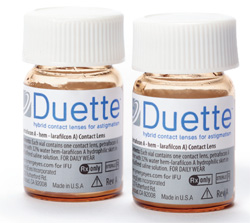• The Heart of America Contact Lens Society (HOACLS ) and Primary Care Congress is accepting abstracts based on unique clinical cases and all aspects of optometric research for its inaugural Clinical and Scientific Poster Session at the 2011, 50th Anniversary Convention. All case reports and research must be complete and unpublished before January 1, 2011. Submit your abstracts via email to [email protected] before November 1, 2010.
• A new educational website from SynergEyes, Inc.,
www.treatkeratoconus.com, provides a resource for patients and their families to learn about keratoconus and available treatment options. The site includes a blog with articles written by doctors who specialize in treating keratoconus and detailed information on a new program, Sharing Vision Grant Program, created to provide hybrid contact lenses to selected patients free of charge and sponsored by SynergEyes, Inc.
TreatKeratoconus.com has several informative sections including Common Questions, Treatment Options, Hybrid Contact Lens Technology and Ask An Expert.
• Abb Concise has begun distributing PolyVue’s high definition multifocal progressive and high definition aspheric soft contact lenses. PolyVue HD lenses feature patented spherical aberration control optics, improved depth of field and reduced refractive astigmatism. These lenses incorporate Comfort Perfected lens edge design and Hypathin cast-mold manufacturing as well as additional patented optics that provide simultaneous correction for near, intermediate and distance vision while simulating natural stereo accommodation equally in both eyes. Most PolyVue fits are binocular rather than the modified monovision. PolyVue HD Aspherics can be fit for single vision and emerging presbyopes with up to a +1.00D add.
Clinical Trials of Dry Eye Solution
ISTA Pharmaceuticals, Inc. has initiated a Phase 3 clinical program of Remura (bromfenac ophthalmic solution for dry eye), a sterile, topical, non-steroidal anti-inflammatory (NSAID) compound for alleviating the signs and symptoms of dry eye disease. The Phase 3 efficacy studies are being conducted under a Special Protocol Assessment (SPA) agreed upon with the FDA.
At this time, ISTA plans to assess the safety and efficacy of Remura in alleviating the signs and symptoms of dry eye disease by conducting four randomized, double-masked, placebo-controlled Phase 3 studies. These studies will evaluate the efficacy and safety of bromfenac in two simultaneous studies operating under a common protocol in approximately 1,000 patients with mild or moderate dry eye disease.
The multi-center trials will be conducted at more than 30 sites in the U.S. Two concentrations of bromfenac will be dosed in addition to placebo. Patients will be randomized at a ratio of 1:1:1 to receive either bromfenac or placebo in both eyes twice daily and will be evaluated over the course of 42 days. For both efficacy studies, the objective sign of conjunctival staining will be measured using the lissamine green test, and subjective symptoms will be measured using the Ocular Surface Disease Index (OSDI). ISTA will report the findings in the middle of 2011. For more information, go to
www.istavision.com.
An Investigational Procedure for Keratoconus and Ectasia
The Cornea and Laser Eye Institute, with Principal Investigator, Peter S. Hersh M.D., a cornea and refractive surgery specialist in Teaneck, N.J., is examining the safety and effectiveness of corneal collagen crosslinking (CXL) using Riboflavin/Dextran and Hypotonic Riboflavin in patients with progressive keratoconus and corneal ectasia. The goal of the study is to assess the safety and efficacy of crosslinking for the treatment of keratoconus as well as corneal ectasia after LASIK.
During the crosslinking procedure, anesthesia drops are administered. The surface epithelial cells of the cornea are then removed and riboflavin drops are administered for 30 minutes. The riboflavin acts both to enhance the crosslinking effect and to protect the rest of the eye from the UV exposure. The patient then looks at a UV-emitting light for 30 minutes. At the conclusion of the procedure, a soft bandage contact lens is applied. The contact lens is left in place to improve healing for approximately five days and is then removed. Antibiotic and anti-inflammatory drops are used for two weeks afterwards. If successful, CXL may decrease progression of keratoconus and maintain patients’ vision over time.
A Wetting Agent for SiHy Lenses
A new wetting agent from Alcon, Inc. is a synthetic block copolymer that uses proprietary polymer chemistry, EOBO, poly (oxyethylene)-poly (oxybutylene), and is designed for improving wettability properties of silicone hydrogel contact lenses. A poster presentation at ARVO indicated that a test solution containing EOBO reduced the surface and bulk hydrophobicity and improved the hydrophilic properties of silicone hydrogel lenses vs. a saline solution control. EOBO has an extremely high affinity for the hydrophobic areas of silicone hydrogel contact lenses and targets sites on and in the lens to retain moisture.1
Alcon is developing the EOBO technology specifically for silicone hydrogel contact lenses and is exploring further development to provide this benefit in the company’s contact lens care product line.
1. Davis J, Ketelson HA, Shows A, Meadows DL. A lens care solution designed for wetting silicone hydrogel materials. Poster. ARVO. May 2010.
 A New Hybrid Lens
A New Hybrid Lens
The Food and Drug Administration (FDA) has approved SynergEyes, Inc’s application for a next-generation silicone hydrogel hybrid contact lens. The new hybrid platform is cleared for use in the correction of hyperopic, myopic and astigmatic refractive error—including presbyopia, in aphakic and non-aphakic, non-diseased eyes. The lenses are indicated for daily wear for the correction of up to +20.00D and -20.00D in eyes with astigmatism up to +6.00D.
SynergEyes will market the new hybrid technology as two contact lens products: Duette hybrid contact lenses for astigmatism and Duette Multifocal for presbyopia. The Duette hybrid contact lens products feature a new SynergEyes-developed RGP material, MaxVu and a proprietary Flex2O silicone hydrogel skirt. Duette hybrid contact lenses for astigmatism are currently available in limited release in select practices in the U.S. A nationwide launch is planned for early 2011.


